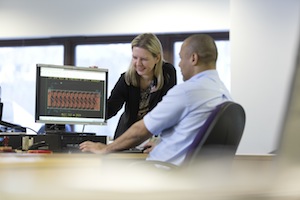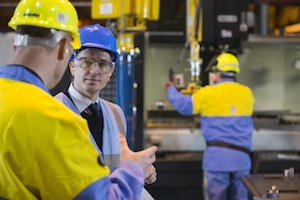 AMS visited Tata Steel's new £3.1m profiling centre at Steelpark, Wolverhampton, UK, to speak to its director of heavy gauge decoiling and plate profiling
AMS visited Tata Steel's new £3.1m profiling centre at Steelpark, Wolverhampton, UK, to speak to its director of heavy gauge decoiling and plate profiling
Joanne Perry (JP): Tata Steel has a number of facilities across the UK and Ireland. What was the objective of the recent investment at Steelpark?
Mick Horan (MH): It really was about bringing together multiple sites, taking cost out, creating a national hub and driving service. So that’s the fundamental strategy. Additional to that, we’ve taken the opportunity to upgrade our capability. So really, two things: to create a national hub with increased capacity and then investment in capability as well.
JP: One of the key aspects of this centre is the combination of the profiling and the finishing. If that’s so beneficial, why aren’t other companies doing the same?
MH: I think they are, in some cases. Most companies which profile or laser will have some finishing. What we think is unique is the scale and scope of what we’ve got, which is the full range of gas, plasma and laser under one roof, with a really wide range of secondary and tertiary processing.
JP: The annual production capacity has increased to 47,000 tonnes. How soon do you think you will actually produce that volume?
MH: We are probably two-thirds of the way there now, and it will come in two phases. We’ve still got capacity to install; we’ve got two plasma lines still to put in, and a laser line. Then we’ve got the challenge of training the workforce, some of whom haven’t operated in this environment before. We’ll have the new lines in by the end of March, and in terms of driving productivity – that’s a lifetime’s journey for our business! We think it will be six months before we get back to the full productivity we would have been at in a stable business, but then we want to go beyond that. So it will probably be September or October before we’re at that sort of capacity capability.
JP: So you do expect to operate at maximum capacity – the demand is there?
MH: Absolutely. This isn’t us putting some kit in and thinking “What are we going to do with it?”. I’ve got an orderbook now that I am turning down because I haven’t got the capability to service it. I’m pushing my operating manager to accelerate the builds on the machines, and we’ve brought those forward. By the original timetable we would have finished the construction by summer, so we’re trying to finish that by April and that’s directly because we’ve got customers that are asking for the capacity.

MH: Mainly UK, because we’ve focused this as a UK national hub for profiling. But we’re starting to get some strong interest from customers that we serve in the UK that are wanting us to service their plants abroad. Titan is a good example of that. We’ve recently won the business for Titan in France and we are looking at Ireland.
JP: Roughly what proportion of your customers are automotive?
MH: About 5% are in the automotive sector directly. We’re probably 5% automotive, 70% lifting and excavating, which includes everything from tractors through to diggers, we are probably 5 or 10% into the energy sector, so that’s offshore wind towers, nuclear, oil and gas, and then general engineering is our balance.
JP: Is the proportion of automotive customers likely to increase?
MH: I think it probably will be stable. Our challenge in all our sectors is about cost and weight efficiencies. And we’re at the heavy end of steel profiling and steel processing, so it needs to be specialist applications in terms of automotive. But we are seeing the same trends that the automotive industry has followed being applied by other sectors now. Whereas 10 years ago people wanted tractors and dumpers as heavy as possible, now with energy efficiency and European carbon emissions regulations on engines there’s a challenge to redesign some of the heavy kit to optimise the efficiency.
JP: How many tonnes of raw material do you have coming into the centre per day and per week?
MH: When we hit our capacity of 47,000 tonnes, we’re looking at 1,000 tonnes per week. Based on five days, we’re looking at 200 tonnes a day of raw material coming in. We’re operating at two-thirds of that at the moment. So that’s 200 tonnes coming in and probably about 140 tonnes of finished components going out because of the impact of nesting and yield.
JP: What techniques do you use to keep waste to a minimum?
MH: One of the essential parts of what we do is product and efficiency design. A customer will come to us and ask for a product or a shape and we’ll look at how to manufacture it. But then we get into dialogue with the customer, we try to understand what they want it for, and very often we can suggest improvements that either take cost or weight out or give a yield efficiency that we can pass back to them.

MH: We use a system called Stratix, which is inventory and operations management software that tracks our product from wide plate to dispatch to the customer and everything in between. That is so important, because one of the key elements for our customers is traceability. Because of the nature of the industry we are supplying, our customers want traceability not only through our processes but right the way back to steel manufacture. Very often they are safety critical components that we are manufacturing.
JP: One of the advantages of the centre is that it will reduce the order and delivery times, how will that happen at ground level?
MH: First of all, we’ve combined two sites in recent years but actually over the last five years probably four sites into one. This recent move is the last two into one. What we’ve done then is consolidate supply chains. Being part of Tata Steel, when we talk about a supply chain we are talking literally from steel make to customer, so that gives us a unique opportunity. We see all the steel in the mill supply chain through manufacturing, and that lets us optimise our delivery schedules to customers, so we’re not having to build up big stocks to buffer against a boat coming in from China. I’m able to talk to the senior logistics guy in the mill on a Friday night and arrange for a part ultimately to go onto a customer machine on a Monday morning, finished and painted.
JP: How does the new profiling centre fit with the other facilities at Steelpark – the automotive and light gauge centres?
 By consolidating its sites, Tata Steel now has 36 qualified engineers at Steelpark
By consolidating its sites, Tata Steel now has 36 qualified engineers at SteelparkWhen we were at Cradley, we had six engineers. On this site now we’ve got 36 qualified engineers, and that just gives you a range of flexibility and capability on the site. We are in the process of creating one engineering team that provides a central service to all four businesses.
We have one supply chain management team that manages the supply of steel across all these businesses, so we can plan transport deliveries to customers and reduce costs that way. Ultimately, there will be 1,000 tonnes going through the site and you can imagine the number of vehicles in and out every day. So managing that as one platform gives us some real synergies. We’ve standardised the shift patterns so we can move teams of people between businesses. That was our ambition and partly the reason for coming here.


































